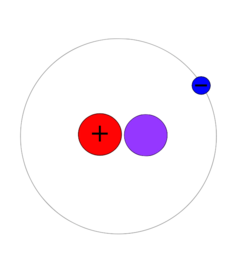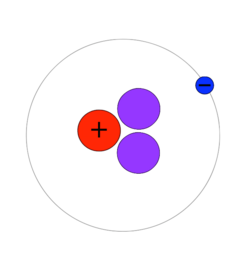نظائر الهيدروجين
| |||||||||||||||||||||||||||||||||||||||||||||||||||||||
Hydrogen (1H) has three naturally occurring isotopes, sometimes denoted 1H, 2H, and 3H. 1H and 2H are stable, while 3H has a half-life of 12.32 ± 0.02 years.[1][nb 1] Heavier isotopes also exist, all of which are synthetic and have a half-life of less than one zeptosecond (10−21 s).[3][4] Of these, 5H is the least stable, while 7H is the most.
Hydrogen is the only element whose isotopes have different names that remain in common use today: the 2H (or hydrogen-2) isotope is deuterium[5] and the 3H (or hydrogen-3) isotope is tritium.[6] The symbols D and T are sometimes used for deuterium and tritium. The IUPAC accepts the D and T symbols, but recommends using standard isotopic symbols (2H and 3H) instead to avoid confusion in the alphabetic sorting of chemical formulas.[7] The isotope 1H, with no neutrons, is sometimes called protium.[8] (During the early study of radioactivity, some other heavy radioactive isotopes were given names, but such names are rarely used today.)
قائمة النظائر
| Nuclide[9] |
Z | N | Isotopic mass (Da)[10] [n 1] |
Half-life |
Decay mode [n 2] |
Daughter isotope [n 3] |
Spin and parity [n 4][n 5] |
التوافر الطبيعي (mole fraction) | ملاحظة | ||||||||||
|---|---|---|---|---|---|---|---|---|---|---|---|---|---|---|---|---|---|---|---|
| Normal proportion | Range of variation | ||||||||||||||||||
| 1H | 1 | 0 | 1.007825031898±0.000000000014 | Stable[n 6][n 7] | 1/2+ | [0.99972, 0.99999][11] | Protium | ||||||||||||
| 2H (D)[n 8][n 9] | 1 | 1 | 2.014101777844±0.000000000015 | Stable | 1+ | [0.00001, 0.00028][11] | Deuterium | ||||||||||||
| 3H (T)[n 10] | 1 | 2 | 3.016049281320±0.000000000081 | 12.32±0.02 y | β− | 3He | 1/2+ | Trace[n 11] | Tritium | ||||||||||
| 4H | 1 | 3 | 4.026431867±0.000107354 | 139±10 ys | n | 3H | 2− | ||||||||||||
| 5H | 1 | 4 | 5.035311492±0.000096020 | 86±6 ys | 2n | 3H | (1/2+) | ||||||||||||
| 6H | 1 | 5 | 6.044955437±0.000272816 | 294±67 ys | 3n | 3H | 2−# | ||||||||||||
| 4n | 2H | ||||||||||||||||||
| 7H | 1 | 6 | 7.052749±0.001078# | 652±558 ys | 4n | 3H | 1/2+# | ||||||||||||
| This table header & footer: | |||||||||||||||||||
- ^ ( ) – Uncertainty (1σ) is given in concise form in parentheses after the corresponding last digits.
- ^
أنماط الاضمحلال:
n: Neutron emission - ^ Bold symbol as daughter – Daughter product is stable.
- ^ ( ) spin value – Indicates spin with weak assignment arguments.
- ^ # – Values marked # are not purely derived from experimental data, but at least partly from trends of neighboring nuclides (TNN).
- ^ Unless proton decay occurs.
- ^ This and 3He are the only stable nuclides with more protons than neutrons.
- ^ Produced during Big Bang nucleosynthesis.
- ^ One of the few stable odd-odd nuclei
- ^ Produced during Big Bang nucleosynthesis, but not primordial, as all such atoms have since decayed to 3He.
- ^ Cosmogenic
Hydrogen-1 (Protium)
Hydrogen-2 (Deuterium)
Hydrogen-3 (Tritium)
Hydrogen-4
Hydrogen-5
Hydrogen-6
Hydrogen-7
Decay chains
Decay times are in yoctoseconds (10−24 s) for all these isotopes except 3H, which is expressed in years.
انظر أيضاً
- Hydrogen isotope biogeochemistry
- Hydrogen-4.1 (Muonic helium)
- Muonium – acts like an exotic light isotope of hydrogen
 وسائط متعلقة بـIsotopes of hydrogen من مشاع المعرفة.
وسائط متعلقة بـIsotopes of hydrogen من مشاع المعرفة.
الهوامش
- ^ Note that NUBASE2020 uses the tropical year to convert between years and other units of time, not the Gregorian year. The relationship between years and other time units in NUBASE2020 is as follows: 1 y = 365.2422 d = 31 556 926 s
المصادر
- ^ أ ب Kondev, F. G.; Wang, M.; Huang, W. J.; Naimi, S.; Audi, G. (2021). "The NUBASE2020 evaluation of nuclear properties" (PDF). Chinese Physics C. 45 (3): 030001. doi:10.1088/1674-1137/abddae. خطأ استشهاد: وسم
<ref>غير صالح؛ الاسم "NUBASE2020" معرف أكثر من مرة بمحتويات مختلفة. - ^ Magurno, B.A.; Pearlstein, S, eds. (1981). Proceedings of the conference on nuclear data evaluation methods and procedures. BNL-NCS 51363, vol. II (PDF). Upton, NY (USA): Brookhaven National Lab. pp. 835 ff. Retrieved 2014-08-06.
- ^ Y. B. Gurov; et al. (2004). "Spectroscopy of superheavy hydrogen isotopes in stopped-pion absorption by nuclei". Physics of Atomic Nuclei. 68 (3): 491–497. Bibcode:2005PAN....68..491G. doi:10.1134/1.1891200. S2CID 122902571.
- ^ A. A. Korsheninnikov; et al. (2003). "Experimental Evidence for the Existence of 7H and for a Specific Structure of 8He". Physical Review Letters. 90 (8): 082501. Bibcode:2003PhRvL..90h2501K. doi:10.1103/PhysRevLett.90.082501. PMID 12633420.
- ^ IUPAC, Compendium of Chemical Terminology, 2nd ed. (the "Gold Book") (1997). Online corrected version: (2006–) "deuterium".
- ^ IUPAC, Compendium of Chemical Terminology, 2nd ed. (the "Gold Book") (1997). Online corrected version: (2006–) "tritium".
- ^ قالب:RedBook2005
- ^ IUPAC, Compendium of Chemical Terminology, 2nd ed. (the "Gold Book") (1997). Online corrected version: (2006–) "protium".
- ^ Half-life, decay mode, nuclear spin, and isotopic composition is sourced in:
Kondev, F. G.; Wang, M.; Huang, W. J.; Naimi, S.; Audi, G. (2021). "The NUBASE2020 evaluation of nuclear properties" (PDF). Chinese Physics C. 45 (3): 030001. doi:10.1088/1674-1137/abddae. - ^ Wang, Meng; Huang, W.J.; Kondev, F.G.; Audi, G.; Naimi, S. (2021). "The AME 2020 atomic mass evaluation (II). Tables, graphs and references*". Chinese Physics C. 45 (3): 030003. doi:10.1088/1674-1137/abddaf.
- ^ أ ب "Atomic Weight of Hydrogen". CIAAW. Retrieved 24 June 2021.
{{cite web}}: CS1 maint: url-status (link)
قراءات إضافية
- Dumé, B. (7 March 2003). "Hydrogen-7 makes its debut". Physics World.




![{\displaystyle {\begin{array}{rcl}\\{\ce {^{3}_{1}H}}&{\ce {->[12.32\ {\ce {y}}]}}&{\ce {{^{3}_{2}He}+e^{-}}}\\{\ce {^{4}_{1}H}}&{\ce {->[139\ {\ce {ys}}]}}&{\ce {{^{3}_{1}H}+{^{1}_{0}n}}}\\{\ce {^{5}_{1}H}}&{\ce {->[86\ {\ce {ys}}]}}&{\ce {{^{3}_{1}H}+{2_{0}^{1}n}}}\\{\ce {^{6}_{1}H}}&{\ce {->[294\ {\ce {ys}}]}}&{\ce {{^{3}_{1}H}+{3_{0}^{1}n}}}\\{\ce {^{6}_{1}H}}&{\ce {->[294\ {\ce {ys}}]}}&{\ce {{^{2}_{1}H}+{4_{0}^{1}n}}}\\{\ce {^{7}_{1}H}}&{\ce {->[652\ {\ce {ys}}]}}&{\ce {{^{3}_{1}H}+{4_{0}^{1}n}}}\\{}\end{array}}}](https://wikimedia.org/api/rest_v1/media/math/render/svg/ffe7273e43be389ade37cbbc0ef6d631af261fe1)